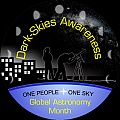|
April 17 By Mario E Motta, M.D |
Back to the GAM DSA Blog |  |
| Many are well aware of the various non medical problems associated with light pollution, such as energy waste, sky glow, and environmental impact. | ||
But not many people know about the burgeoning growth of research that demonstrates direct human-health issues related to excess light. Though we certainly need to be mindful of wasting energy, health effects might ultimately be the most important reason to control light pollution. The energy wasted by excessive lighting is produced primarily by burning fossil fuels, leading directly to air pollution that causes higher asthma rates and increased respiratory problems for people with lung disease and other medical issues.
Glare is the most common health safety problem resulting from poorly designed outdoor lighting. You have probably noticed poor vision stemming from glare on a dirty windshield. Over time, calcifications build up in the lenses of our eyes, which eventually develop into a cataract. These calcifications and other lens and eye imperfections scatter light in a similar fashion to a dirty windshield. This effect grows more severe with age, and is the primary reason why the elderly have a difficult time driving at night near poorly designed street lights. Most people with this problem are not even aware that it’s the glare that’s the main cause of their poor night vision, and that they would be able to drive more safely if street lights were properly designed with full shielding. Recognizing that our streets could be safer places at night, the American Medical Association (AMA) adopted a resolution in 2009 urging full shielding for all public street lighting.
A very active new area of research is the effect of night light on circadian-rhythm disruption. Numerous papers over the past 20 years have led medical researchers to conclude that light at night increases the incidence of certain cancers, most notably breast cancer. In fact, researchers now estimate that up to 30% of breast cancers are secondary to light at night suppressing circadian rhythm. The research basis for this conclusion has become so compelling that the International Agency for Research on Cancer (IARC) recently declared circadian-rhythm disruption as a class 2A carcinogen — placing it on the same level of severity as the effects of tobacco smoke on lung cancer. Light-at-night and circadian disruptions have been suggested to play a role in other cancers including endometrial, ovarian, prostate, colorectal, and non-Hodgkins lymphoma but evidence comparable to that obtained for breast cancer has not yet been developed.
The biochemical mechanism for this has been thoroughly researched and is thought to result from the suppression of melatonin production by the pineal gland in the center of our brain. This gland produces the hormone melatonin while we sleep. Repeated exposure to lights for night-shift workers or in our bedrooms markedly suppresses melatonin production. Previous research has shown that this hormone helps the immune system suppress the development of several types of cancers.
The modern world has an epidemic of obesity and diabetes that may be influenced by lack of sleep, lack of dark, and/or circadian disruption. Non-day shift workers have a higher incidence of diabetes and obesity. Epidemiological studies also show associations of reported sleep duration and risk of obesity and diabetes. Circadian disruption may be a common mechanism for these outcomes and potential links between the circadian rhythm and metabolism.
As an elected member of the AMA’s Council of Science and Public Health, I have asked the world’s five foremost researchers on this subject to help me draft a review monograph to summarize these important studies. After a year of work, this report has been approved by the Council of Science and Public health of the American Medical Association, and is on the docket for a full vote of the AMA House of delegates in June to be adopted as official policy of the AMA. It is my hope that this report will prod governments and municipalities adopt sensible and rational lighting policies.
|
|
Mario E Motta, M.D. I am a cardiologist at the North Shore Medical Center in Salem, Massachusetts, and a recent President of the Massachusetts Medical Society (2010). I have been elected to serve on the Council of Science and Public health of the AMA, serving in my forth year currently. I am currently serving as president of the American Association of Variable Star Observers. (AAVSO). I am also an avid amateur astronomer, and observe with my homebuilt 32 inch telescope from my home observatory. I have been very active in the battle on light pollution for many years, I am currently a board member of the IDA (International dark Sky Association). |








